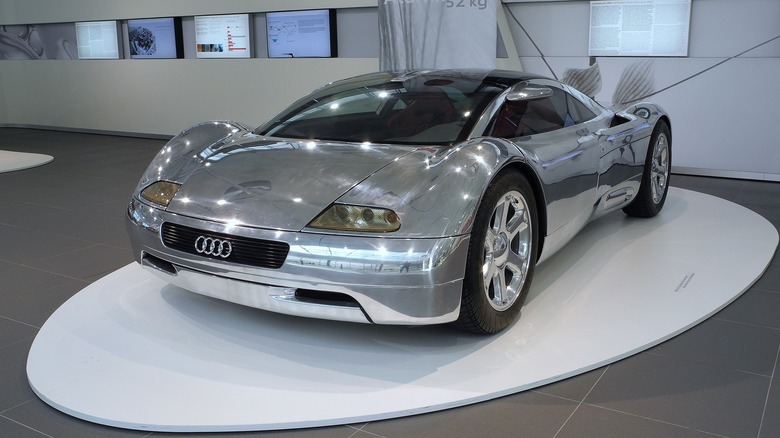The Audi Mid-Engine Supercar Concept We Wish Made It To Production
A funny thing happened on the way to the 1991 Tokyo Auto Show. While Audi did wow the crowd with its Avus Quattro concept car, something was missing. Those who laid eyes on the gleaming beast during its appearance were none the wiser.
The purpose of the Avus was twofold: First, it was meant as a way to formally present unto the world its twelve-cylinder W12 engine — the crown jewel it would soon put into the yet-to-be-released Audi A8 (via Top Gear). Its second goal was to usher in Audi's aluminum age of car manufacturing, a concerted effort to build cars with as much aluminum as possible. So why not wrap it all up in the company's first foray into the realm of supercars? As such, the Avus can be considered the grandpappy to Audi's R8 line of supercars (per Top Gear).
The W12 was a naturally aspirated (via Audi), 6.0-liter 509 horsepower gasoline monster (via Top Gear). Scissor doors opened into an interior with twin red bucket seats that wrapped passengers in a cocoon of safety. A huge NACA-style cooling duct was mounted on the roof, and it came with three lockable differentials, rear-wheel steering, Quattro all-wheel drive, and a 6-speed manual transmission (via Motor1). The shallow profile boasted incredible aerodynamics, and amazingly, the 20-inch wheels comprised half of the car's total height.
Audi faked it, but Mattel made it
While the exterior looks like chrome and is as shiny as SpaceX's Starship, the body was made entirely of hand-beaten aluminum panels a mere 1.5-mm thick (via Top Gear). Between the all-aluminum body atop Audi's Space Frame, the car only weighed 2,755 pounds (via Motor1).
All said and told, the W12 engine — coupled with the sleek concept's aerodynamic features — theoretically had a top speed of around 211 mph, and could go from 0-62 mph in 3.0 seconds flat (per Top Gear). Yes, theoretically, because the engine in the Avus Quattro on display at the Tokyo Auto Show wasn't real. The "engine" people viewed through the rear window was a wooden facsimile covered with plastic. The real W12 was still in development and had not been fully built or tested yet, so ... Audi faked it. And it worked.
Audi never intended to put the car into production, so they were able to cut a few corners to usher in ideas and concepts it intended to follow through with in other vehicles down the line. But the ruse worked so well that rumors persist about people offering to pay Audi $12 million per car to build a working road version of the Avus Quattro concept car (via Motor1).
Few and far between have that kind of money to spend on a car, but not all is lost. Mattel released several different Hot Wheels versions, making the supercar affordable for everyone.
